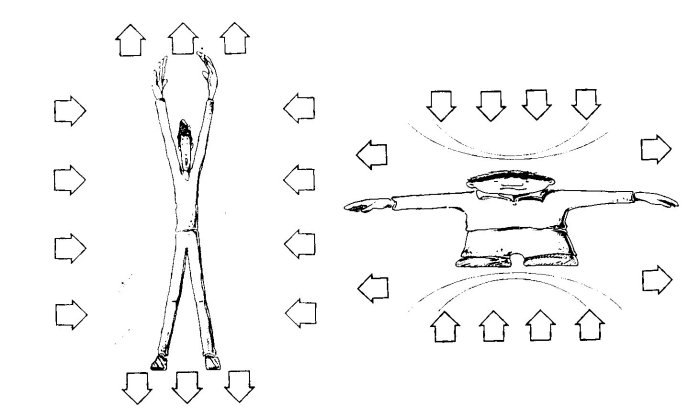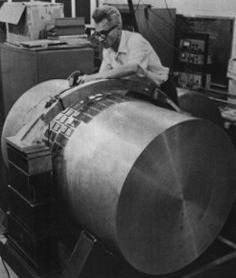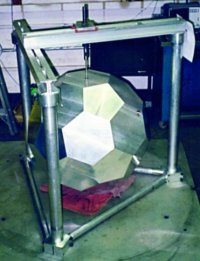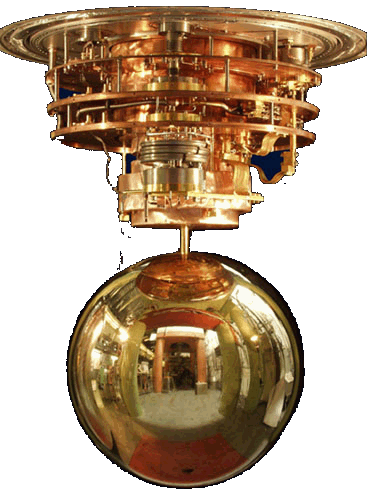
Tidal forces

The search for gravitational waves (gw) began in the 1960s with Joseph Weber. In 1966 he constructed the first resonant-mass detector--a large aluminum cylinder (two meters long, half a meter in diameter) held at room temperature and isolated from vibrations in a vacuum chamber.
The idea is that a gw traveling perpendicular to the cylinder's axis will produce tidal forces that stretch and contract the length of the cylinder. If the frequency of the gw is close to the resonant frequency of the bar, the change in length will be detectable. Weber used a piezoelectric crystal to detect the changes in length and produce an electrical signal. Today, resonant-mass groups use capacitive transducers.
In 1969, Weber had many detectors and claimed that he had observed coincidences between them--he had observed gws. Other groups could not confirm Weber's claim and it does not seem likely that he did detect any. At that time, the sensitivity could only allow strains on 10^-16 to be detected which should not be enough to detect gws.

Improvements to the detectors occurred over the next few decades. Modern-day detectors such as ALLEGRO and EXPLORER are now kept at 4K to lower noise from thermal vibrations. Design alterations to how the detector was suspended in its vacuum chamber improved its isolation from other vibrations. A resonant transducer and low noise amplifier is used to observe the motion of the bar which amplifies the displacement but attenuates large amplitude vibrations at low temperatures.
Further reductions in temperature are possible--in fact final tests of 50mK detectors were performed in 1991--but improvements have not been demonstrated. Good ultra-low temperature detectors are being sought after.
In general, resonant-mass detectors are cheaper and easier to build than interferometers and potentially have a greater sensitivity than ground-based interferometers. Their main limiting factor is that they have a very narrow bandwidth--they only detect frequencies around the resonant frequency. To paraphrase Kip Thorne, a xylophone is needed to detect the entire symphony of the universe.
These are resonant-mass detectors run by the Louisiana State University.
ALLEGRO (A Louisiana Low temperature Experiment and Gravitational wave Observatory) ran between June 1991 and January 1995 operating at strain values of 1e-21 per root Hz. It could detect gws whose frequencies fell in two narrow bands near 900Hz. Coincidences were looked for with EXPLORER but none were found. ALLEGRO began a second data collection run in 1996 with slightly decreased sensitivity as a compromise to get better stability and no non-gaussian noise. The aim is to find a new upper limit for gravitational wave flux.
ALLEGRO is sensitive enough to detect a gravitational collapse in our galaxy if the energy converted to gws is a few percent of a solar mass. This type of event is not expected to occur that often. In the Virgo cluster, this event probably occurs several times a year but the sensitivity of the detectors would need to be increased by a factor of six to detect waves from that far away.

TIGA (Truncated Icosahedral Gravitational Wave Antenna) should achieve this. It can detect gws from all directions and polarizations (which can also be achieved with a minimum of five separate cylinders) and has a larger mass than a cylinder with the same resonant frequency. The larger mass gives it a larger cross-section and makes it more sensitive to gws.
TIGA will be six detectors. A test model has already been constructed (with a resonant frequency of 3200Hz) but a complete investigation into the practicability has not been completed.
NIOBE is a resonant-mass detector run by the University of Western Australia. The cylinder is made from niobium and has resonant frequencies around 700Hz. Strain sensitivity of 1e-22 can be achieved. It is operated at liquid helium temperatures (2-5K).
The AURIGA detector is installed in North-East Italy. It is an aluminum cylinder enriched in magnesium to guarantee high quality factors (Q) to maximize the sensitivity. The resonant frequency is about 1kHz and it operates at 0.1K.
At the present, AURIGA can detect events in the galactic center (50kPc away). No actual events are expected but it will place an upper limit to the event rate.
Upgrades in sensitivity and bandwidth are planned and on the way. They should increase the range of AURIGA so that it can detect events in the Local Group of galaxies (5MPc away). Plus, it should be able to detect spinning neutron stars and (when results are compared to other detectors) the stochastic background.
This resonant-mass detector operates at CERN and is an aluminum bar operating at liquid helium temperatures (2-5K).
This resonant-mass detector operates at the INFN (Istituto Nazionale di Fisica Nucleare) Frascati Laboratory in Italy and is an aluminum bar cooled to 1.5K.

The GRAIL project was from the Leiden University in the Netherlands but has unfortunately not received funding.
The team are now working on the miniGRAIL which is, as its name suggests, a scaled-down version of what they originally planned. It is spherical with a diameter of 65cm. The metal is a copper/aluminum alloy with a resonant frequency of 3250 Hz and a relatively large bandwidth compared to cylindrical detectors of 230Hz. The strain it can measure is restricted to be 4e-21 by the quantum limit at an operating temperature of 20mK.
Originally, Weber used piezoelectric crystals to directly detect the squeezing effect of gws. When squeezed, an electric voltage develops in these crystals. Weber made a circuit out of these crystals and glued them to the middle of the aluminum cylinder so that the squeezing and stretching of the cylinder at resonant frequency would produce a measurable oscillating voltage.
Today, we use a different method. The gw will stretch and compress the cylinders. This does work and energy is therefore added or subtracted to the cylinder. The vibrational amplitude of the cylinder is therefore changed by a gw and it is this change that we hope to detect. The energy change depends on the mass of the cylinder so in theory the greater the mass, the greater the sensitivity.
This change would only occur for an instant and be undetectable unless the frequency of the gw matches the resonant frequency of the cylinder. The gws excite those vibrational modes that have a mass quadrapole moment such as the fundamental longitudinal mode. This fundamental frequency can be tuned by changing the dimensions of the bar. Therefore, increasing the sensitivity of the bar does not equate with increasing its size.
It has been suggested that with the new generation of ultra-cryogenic spherical resonant-mass detectors, strains of 1e-23 per root Hz will be able to be detected. This is close to the quantum limit.
The EXPLORER and NAUTILUS groups have detected what may be gws. They are hesitant to declare 100% confidence in their find and are currently collecting new data and looking forward to results from the interferometry groups.
In 2001 these two resonant-mass detectors found approximately one coincidence per day with a signal energy of 100mK. This corresponds to a strain of 2e-18 and the conversion of 0.004 solar masses into gws.
This event rate is larger than expected from models but within the upper limit for coalescing binary sources determined by LIGO.
The groups took great care in eliminating the possibility that these coincidences were from cosmic ray showers but are open to the possibility that there are other phenomena causing them. They suggest that a possible way to distinguish a gw from another source is to measure the other vibrational modes of the resonant-mass detector and verify that only the quadrapole modes are excited. This step will be possible with the proposed spherical detectors.